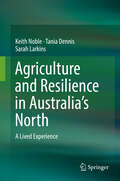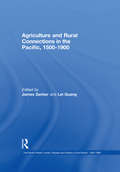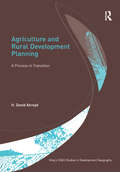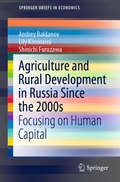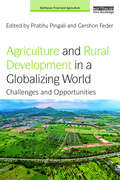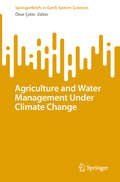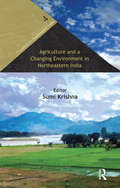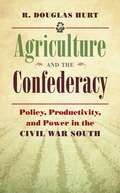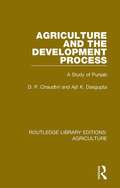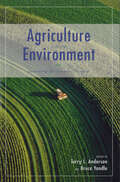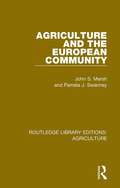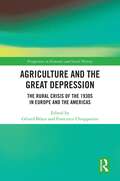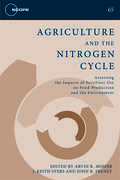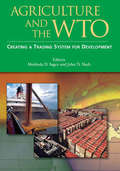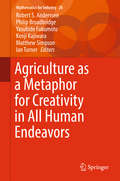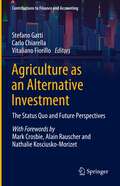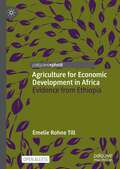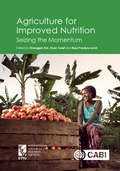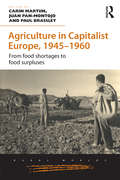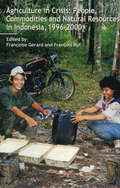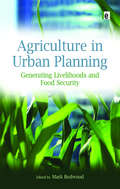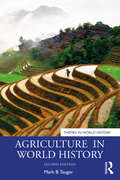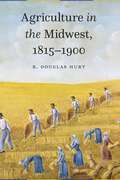- Table View
- List View
Agriculture and Resilience in Australia’s North: A Lived Experience
by Keith Noble Tania Dennis Sarah LarkinsThis book examines the mechanisms and strategies farmers in North Australia adopt to manage the setbacks and challenges they face. This social research is based on farmers’ experiences, but also draws on the author’s own experience after his tropical fruit farm was destroyed by two Category 5 cyclones in five years.Through historical analysis, the book compares historic and contemporary aspirations for northern development, and discusses the influence of the built environment on individuals as well as access to health and other social services.Exploring the implications of individual resilience strategies for policy development within the broader context of northern development and evolving environmental governance, the book also highlights the fact that this is occurring in a new geological epoch – the Anthropocene.The book will provide a unique perspective and understanding to government, individuals and industries interested in northern Australia and its relationship to the world
Agriculture and Rural Connections in the Pacific (The Pacific World: Lands, Peoples and History of the Pacific, 1500-1900)
by Lei GuangAgriculture and Rural Connections in the Pacific brings together key studies from across several disciplines to examine the history of trans-Pacific rural and agricultural connections and to show an agriculturally-oriented Pacific World in the making since the 1500s. Historical globalization is commonly understood as a process that is propelled by industry or commerce, yet the seeds of global integration - literally as well as metaphorically - were sown much earlier, when crops and plants dispersed, agricultural systems proliferated, and rural people migrated across oceans. One goal of this volume is to demonstrate that the historical processes of globalization contained an agrarian dimension in which sub-national and national spaces were shaped in part through the influence of forces that originated in distant lands. Social and economic trends emanating from outside local territories had large impacts on demographic change, choices of agrarian systems, and the cropping patterns in many domestic settings. A second goal is to encourage readers to abandon the traditional Euro-centric view of events that shaped the Pacific region. The modern history of the Pacific World was undoubtedly shaped by Western imperialism, colonialism, and European trade and migration, but the present volume seeks to balance the interpretation of those forces with an emphasis on the increasing intensity of trans-Pacific interactions through rural labor migration and agricultural production.
Agriculture and Rural Development Planning: A Process in Transition (King's SOAS Studies in Development Geography)
by H. David AkroydThis book meets the needs of teachers and students of agriculture and rural development project and programme planning, planners employed by governments in developing countries and by external financing agencies. Project planners must understand the aspirations of rural families and their local leaders, the national development and sector planning goals and policies of their governments and the development goals and policy priorities perceived by external financing agencies in relation to their countries. These areas are not always consistent and trade-offs may be required. However it is recognised that poor project planning is a major constraint to the sustainable realization of project and programme objectives and sector goals. Illustrated with case studies and logical framework matrices, this book presents well-established and relatively new practices followed in the context of agriculture and rural development project and programme planning. Although based on experiences gained in Africa, the issues described are relevant to planning problems encountered in other developing regions of the world. It addresses the main factors which affect the success of planning such as a government's ability to guarantee macro-economic stability and sound sector development policies; the shift from 'top-down', bureaucratic to 'bottom-up', participatory planning approaches and the roles played by external financing agencies. It explains key technical, financial, economic, environmental, socio-cultural, equity, gender and institutional-strengthening issues concerning planning in rural areas and reviews the planning tools and approaches available. The procurement of goods and services, the disbursement of funds and monitoring and evaluation requirements are examined in detail.
Agriculture and Rural Development in Russia Since the 2000s: Focusing on Human Capital (SpringerBriefs in Economics)
by Lily Kiminami Andrey Baldanov Shinichi FuruzawaThis book clarifies the status quo and mechanisms of agricultural and rural development in today’s Russia, especially focusing on human capital and human development. It provides readers insights into agricultural and rural development from the perspectives of agricultural economics, developmental economics, and regional–spatial science. Further, it addresses key research questions such as whether agricultural development in Russia has made significant strides, whether it has improved the nation’s food security and rural development, and whether structural changes in the agricultural sector as well as human capital have had impacts on agricultural development since the 2000s. In terms of analytical methods, structural equation modeling and stochastic frontier analysis are employed to capture the relationship between agriculture and rural development in regional Russia. In closing, policy challenges are identified to promote social innovation for rural development by enhancing the human capital of rural youth, including entrepreneurship. Given its scope, the book is highly recommended for all readers seeking an in-depth and up-to-date overview of agricultural and rural development in contemporary Russia.
Agriculture and Rural Development in a Globalizing World: Challenges and Opportunities (Earthscan Food and Agriculture)
by Prabhu Pingali; Gershon FederRapid structural transformation and urbanization are transforming agriculture and food production in rural areas across the world. This textbook provides a comprehensive review and assessment of the multi-faceted nature of agriculture and rural development, particularly in the developing world, where the greatest challenges occur. It is designed around five thematic parts: Agricultural Intensification and Technical Change; Political Economy of Agricultural Policies; Community and Rural Institutions; Agriculture, Nutrition, and Health; and Future Relevance of International Institutions. Each chapter presents a detailed but accessible review of the literature on the specific topic and discusses the frontiers in research and institutional changes needed as societies adapt to the transformation processes. All authors are eminent scholars with international reputations, who have been actively engaged in the contemporary debates around agricultural development and rural transformation.
Agriculture and Water Management Under Climate Change (SpringerBriefs in Earth System Sciences)
by Öner ÇetinThis book analyzes how major events such as the recent pandemic crisis, wars around the world and climate change, have affected agricultural production and the direct food supply. In this sense, human nutrition will never be off the agenda. The book provides information and guidelines for both practitioners and decision-makers about important developments in the use of agriculture, soil and water resources for agricultural purposes, including the effective and efficient use of soil and water resources where agricultural production, increasing water productivity, the use of modern technology and digitalization for this purpose. Accordingly, a number of chapters have been prepared by experts in the field, covering a variety of the above-mentioned objectives.
Agriculture and a Changing Environment in Northeastern India (Transition In Northeastern India Ser.)
by Sumi KrishnaIndia’s northeastern region, forged by a unique geological history and peopled by several waves of migration, is extraordinarily complex. Farming systems in the hills and the riverine plains are embedded in a heterogeneous environment, comprising forests, wetlands and fields, shaped over centuries by nature and people. Today, the environment and economy are undergoing rapid transformation, affecting peoples’ lives, livelihoods and methods of food production.The essays in this volume bring a multi-disciplinary perspective to critical aspects of the process of agricultural change, examine the gender dimensions of agriculture, and explore initiatives for sustainable livelihood and ecological conservation. Part I analyses the impact of policies and people’s own aspirations on the closely-intertwined ecology and economy of the region. Part II discusses the gender dynamics of farming, forestry and biodiversity in a socio-cultural context where women are primarily responsible for food production. Part III highlights some alternative farming interventions and community-based efforts for environmental conservation, sustainable resource management and improved livelihoods.This book will be useful to scholars and students of agriculture, economics, development, environment and gender studies, and to those involved in policy analysis, natural resource management and community organisation, as also general readers interested in India’s northeastern region.
Agriculture and the Confederacy
by R. Douglas HurtIn this comprehensive history, R. Douglas Hurt traces the decline and fall of agriculture in the Confederate States of America. The backbone of the southern economy, agriculture was a source of power that southerners believed would ensure their independence. But, season by season and year by year, Hurt convincingly shows how the disintegration of southern agriculture led to the decline of the Confederacy's military, economic, and political power. He examines regional variations in the Eastern and Western Confederacy, linking the fates of individual crops and different modes of farming and planting to the wider story. After a dismal harvest in late 1864, southerners--faced with hunger and privation throughout the region--ransacked farms in the Shenandoah Valley and pillaged plantations in the Carolinas and the Mississippi Delta, they finally realized that their agricultural power, and their government itself, had failed. Hurt shows how this ultimate lost harvest had repercussions that lasted well beyond the end of the Civil War.Assessing agriculture in its economic, political, social, and environmental contexts, Hurt sheds new light on the fate of the Confederacy from the optimism of secession to the reality of collapse.
Agriculture and the Development Process: A Study of Punjab (Routledge Library Editions: Agriculture #2)
by Ajit K. Dasgupta D. P. ChaudhriFirst published in 1985. The need to increase agricultural output and to use increased output to generate sustained general economic development is a problem facing many Third World countries. This book explores in particular the agricultural growth of the Punjab in Northern India, a country which has long been a leader in the formulation of new development strategies. It shows how agricultural output is affected by, and affects, demographic changes, income distribution, state involvement and structural changes both in society and the economy. Agricultural growth in the Punjab is seen in an historical perspective. In addition, the different aspects of economic development are viewed in an integrated way so that much is learned about the contribution of agricultural growth to the development process. The conclusions drawn can be related to problems and trends worldwide.
Agriculture and the Environment: Searching for Greener Pastures
by Terry L. Anderson Bruce YandleAlthough US agriculture is the envy of the world, there is a growing gap between what is and what could be produced. The gap is due in part to a growing morass of environmental regulations, which limit US food production without necessarily improving environmental quality. In this compilation, leading experts examine a range of questions posed by these constraints and offer ideas for reform.Authors explore whether we are really running out of prime farmland; how best to preserve environmentally sensitive land, and for how long; whether controls on agricultural land use can prevent urban sprawl; whether chemicals that contribute to agricultural productivity are harmful to the environment; the connections between genetically modified crops and human health; how taxes affect land use; what role water markets play in balancing agricultural productivity and wildlife habitat; and the effects of the Endangered Species Act on land use.
Agriculture and the European Community (Routledge Library Editions: Agriculture #3)
by John S. Marsh Pamela J. SwanneyFirst published in 1980. From the earliest beginnings of the European Economic Community, it was recognised that a common market for agriculture would be one of the basic prerequisites for workable economic unity. And yet the Common Agricultural Policy (CAP) remained a subject of much controversy and debate. The CAP, more than any other element of European policy, was seen to test the true depth of the commitment shown by Community members to the practice as well as the principle of economic integration. Agriculture and the European Community examines the reasons for the existence of the CAP and its format. It outlines the main instruments, price and structural policy, and the changing emphasis between them. It discusses in turn the effects of the CAP on producers’ income levels and on consumer prices; how far it had fulfilled the promises of the Treaty of Rome; the implications of the policy for third country trade; and its place within the Community as a whole. The study argues that, although incomes of Community farmers had improved, this is not simply the result of the CAP, nor was the geographical distribution of benefit in terms of farming income satisfactory. The policy has achieved a degree of success in securing food supplies and stabilising prices but the cost to the consumer has been high. Knowledge of the CAP had become almost essential to any understanding of modern European affairs. Agriculture and the European Community will serve as a straightforward introduction to the policy for students approaching the subject for the first time, especially in departments of Agricultural Economics, European Studies and Political Science.
Agriculture and the Great Depression: The Rural Crisis of the 1930s in Europe and the Americas (Perspectives in Economic and Social History)
by Gérard Béaur Francesco ChiapparinoWhat role did the agricultural sector play in the economic crash of 1929? Taking evidence from country cases across Europe and the Americas, this edited volume explores short-, medium- and long-term perspectives on the primary sector. The monograph brings together the voices of an international panel of contributors who examine issues such as falling prices, industrial production, unemployment and the stagnation of aggregate demand. Together, they frame the interwar period as a pivotal turning point in the decline of subsistence agriculture and the growth of agricultural subsidies, which remain a key policy tool in many economies today. This illuminating book will be of interest to advanced students and researchers in economic history, agricultural history, globalization, and economic development.
Agriculture and the New Trade Agenda
by L. Alan Winters Merlinda D. IngcoThis collection of essays provides the definitive survey of the importance of agricultural reform to the future of the world's trading system. There is growing consensus concerning the need to reduce the level of subsidies in agriculture and to open up the markets of the developed world more to the farmers of the developing world. However, while non-governmental organizations such as Oxfam may agree on this point with free trade economists, governments in Europe and the U. S. seem reluctant to give up their protectionist habits.
Agriculture and the Nitrogen Cycle: Assessing the Impacts of Fertilizer Use on Food Production and the Environment (SCOPE Series #65)
by John R. Freney Arvin Mosier J. Keith SyersNitrogen is an essential element for plant growth and development and a key agricultural input-but in excess it can lead to a host of problems for human and ecological health. Across the globe, distribution of fertilizer nitrogen is very uneven, with some areas subject to nitrogen pollution and others suffering from reduced soil fertility, diminished crop production, and other consequences of inadequate supply. Agriculture and the Nitrogen Cycle provides a global assessment of the role of nitrogen fertilizer in the nitrogen cycle. The focus of the book is regional, emphasizing the need to maintain food and fiber production while minimizing environmental impacts where fertilizer is abundant, and the need to enhance fertilizer utilization in systems where nitrogen is limited. The book is derived from a workshop held by the Scientific Committee on Problems of the Environment (SCOPE) in Kampala, Uganda, that brought together the world's leading scientists to examine and discuss the nitrogen cycle and related problems. It contains an overview chapter that summarizes the group's findings, four chapters on cross-cutting issues, and thirteen background chapters. The book offers a unique synthesis and provides an up-to-date, broad perspective on the issues of nitrogen fertilizer in food production and the interaction of nitrogen and the environment.
Agriculture and the WTO
by John D. Nash Merlinda IngcoDeveloping countries have a major stake in the outcome of trade negotiations conducted under the auspices of the World Trade Organization (WTO). 'Agriculture and the WTO: Creating a Trading System for Development' explores the key issues and options in agricultural trade liberalization from the perspective of these developing countries. Leading experts in trade and agriculture from both developed and developing countries provide key research findings and policy analyses on a range of issues that includes market access, domestic support, export competition, quota administration methods, food security, biotechnology, intellectual property rights, and agricultural trade under the Uruguay Round Agreement on Agriculture. Material is covered in summary and in comprehensive detail with supporting data, a substantial bibliography, and listings of online resources. This book will be of interest to policymakers and analysts in the fields of development economics and commodities pricing and trade.
Agriculture as a Metaphor for Creativity in All Human Endeavors (Mathematics For Industry #28)
by Philip Broadbridge Yasuhide Fukumoto Robert S. Anderssen Kenji Kajiwara Matthew Simpson Ian TurnerThis book is a collection of papers presented at the 'Forum 'Math-for-Industry' 2016 ' (FMfl2016), held at Queensland University of Technology, Brisbane, Australia, on November 21–23, 2016. <P><P>The theme for this unique and important event was “Agriculture as a Metaphor for Creativity in All Human Endeavors”, and it brought together leading international mathematicians and active researchers from universities and industry to discuss current challenging topics and to promote interactive collaborations between mathematics and industry. <P><P> The success of agricultural practice relies fundamentally on its interconnections with and dependence on biology and the environment. Both play essential roles, including the biological adaption to cope with environmental challenges of biotic and abiotic stress and global warming. The book highlights the development of mathematics within this framework that successful agricultural practice depends upon and exploits.
Agriculture as an Alternative Investment: The Status Quo and Future Perspectives (Contributions to Finance and Accounting)
by Stefano Gatti Carlo Chiarella Vitaliano FiorilloUnder the pressure of climate and social changes, agriculture is called to play a fundamental role in the world food challenge of the next few decades. A severe reduction of arable land and water scarcity combined with a growing food demand, changes in the dietary preferences in many countries and, more recently, a growing threat to food security and logistics from supply chains interruptions and global trade fragmentation, all require the implementation of processes, techniques, and innovations able to increase productivity and make a better use of scarce resources.Against this backdrop, a growing number of investors and asset managers have started looking at agriculture as an interesting investment theme to exploit the long-term strategic opportunities emerging from technological innovation and social changes. The industry is undergoing a process of transformation driven, on the one hand, by the emergence of new data and technologies that promise enhancing process efficiency and improve yields and, on the other hand, by an increased attention on the GHG emissions of agricultural processes and the impact of farmland on climate change, water and land scarcity. All these factors call for a radical rethinking of many agriculture business models. This book provides a detailed overview and analysis of those new technologies with the greatest potential to disrupt agriculture products and processes by improving productivity and the management of food loss and waste, making a more efficient and sustainable use of resources and enhancing food security. Then, it discusses the implications for investors and asset managers, starting with an assessment of the status quo of agriculture investing and providing a thorough description of the agriculture asset class with an emphasis on its distinctive characteristics and the innovations in the technological processes used in agriculture and farming with the greatest potential to obtain long-term sustainable returns.
Agriculture for Economic Development in Africa: Evidence from Ethiopia
by Emelie Rohne TillThis book explores the role of agriculture in long-term economic growth. With a particular focus on Ethiopia, the role of the state in igniting agricultural growth and in sustaining economic growth is highlighted as essential for low-income countries. Taking ideas from both economic history and development economics, the ability of Ethiopia and the rest of Africa to sustain recent rapid growth into something that can tackle the development agenda is discussed, alongside policy suggestions.This book overall presents an optimistic account of Africa and its economic prospects. It will be relevant to students and researchers interested in economic development and agricultural economics.This is an open access book.
Agriculture for Improved Nutrition: Seizing the Momentum
by Stuart Gillespie Amy Saltzman Kevin Chen Lawrence Haddad Mathew Abraham Prabhu L Pingali Nicholas Nisbett Suresh Chandra Babu Noora-Lisa Aberman Akhter U. Ahmed Summer Allen Ekin Birol Anne Bossuyt Howarth E. Bouis Gerald F. Jr Olivier Ecker Dr Jessica Fanzo Aulo Gelli Julie Ghostlaw Daniel O. Gilligan Derek Headey Mar Maestre Hazel Malapit William Masters Ruthie Musker Rajul Pandya-Lorch Daniel J. Raiten Marie T. Ruel Zimeiyi Wang Sivan YosefAgriculture's vast potential to improve nutrition is just beginning to be tapped. New ideas, research, and initiatives developed over the past decade have created an opportunity for reimagining and redesigning agricultural and food systems for the benefit of nutrition. To support this transformation, this book reviews the latest findings, results from on-the-ground programs and interventions, and recent policy experiences from countries around the world that are bringing the agriculture and nutrition sectors closer together. Drawing on IFPRI's own work and that of the growing agriculture-nutrition community, this book strengthens the evidence base for, and expands our vision of, how agriculture can contribute to nutrition. Chapters cover an array of issues that link agriculture and nutrition, including food value chains, nutrition-sensitive programs and policies, government policies, and private sector investments. By highlighting both achievements and setbacks, Agriculture for Improved Nutrition seeks to inspire those who want to scale up successes that can transform food systems and improve the nutrition of billions of people. Key features: -Investigates the latest evidence on the relationship between agriculture and nutrition. -Includes insights from internationally renowned researchers. -Presents data from real-world settings that is highly relevant to the challenges faced by developing countries. This book is ideal for policy-makers, practitioners, and students working in agriculture, international development and nutrition.
Agriculture in Capitalist Europe, 1945–1960: From food shortages to food surpluses (Rural Worlds)
by Carin Martiin Juan Pan-Montojo Paul BrassleyIn the years before the Second World War agriculture in most European states was carried out on peasant or small family farms using technologies that relied mainly on organic inputs and local knowledge and skills, supplying products into a market that was partly local or national, partly international. The war applied a profound shock to this system. In some countries farms became battlefields, causing the extensive destruction of buildings, crops and livestock. In others, farmers had to respond to calls from the state for increased production to cope with the effects of wartime disruption of international trade. By the end of the war food was rationed when it was obtainable at all. Only fifteen years later the erstwhile enemies were planning ways of bringing about a single agricultural market across much of continental western Europe, as farmers mechanised, motorized, shed labour, invested capital, and adopted new technologies to increase output. This volume brings together scholars working on this period of dramatic technical, commercial and political change in agriculture, from the end of the Second World War to the emergence of the Common Agricultural Policy in the early 1960s. Their work is structured around four themes: the changes in the international political order within which agriculture operated; the emergence of a range of different market regulation schemes that preceded the CAP; changes in technology and the extent to which they were promoted by state policy; and the impact of these political and technical changes on rural societies in western Europe.
Agriculture in Crisis: People, Commodities and Natural Resources in Indonesia 1996-2001
by Francoise Gerard Francois RufIndonesia's monetary and political crisis is examined here in relation to its impact on Indonesia's agricultural sector. The twelve essays that comprise this volume take a micro-economic approach and analysis relies on observed facts and first-hand data collected both before and after the country's crisis. This is a lively, well illustrated and instructive book.
Agriculture in Urban Planning: Generating Livelihoods and Food Security
by Mark RedwoodThis volume, by graduate researchers working in urban agriculture, examines concrete strategies to integrate city farming into the urban landscape. Drawing on original field work in cities across the rapidly urbanizing global south, the book examines the contribution of urban agriculture and city farming to livelihoods and food security. Case studies cover food production diversification for robust and secure food provision; the socio-economic and agronomic aspects of urban composting; urban agriculture as a viable livelihood strategy; strategies for integrating city farming into urban landscapes; and the complex social-ecological networks of urban agriculture. Other case studies look at public health aspects including the impact of pesticides, micro-biological risks, pollution and water contamination on food production and people. Ultimately the book calls on city farmers, politicians, environmentalists and regulatory bodies to work together to improve the long term sustainability of urban farming as a major, secure source of food and employment for urban populations. Published with IDRC
Agriculture in World History (Themes in World History)
by Mark B. TaugerCivilization from its origins has depended on the food, fibre, and other commodities produced by farmers. In this unique exploration of the world history of agriculture, Mark B. Tauger looks at farmers, farming, and their relationships to non-farmers from the classical societies of the Mediterranean and China through to the twenty-first century. Viewing farmers as the most important human interface between civilization and the natural world, Agriculture in World History examines the ways that urban societies have both exploited and supported farmers, and together have endured the environmental changes and crises that threatened food production. Accessibly written and following a chronological structure, Agriculture in World History illuminates these topics through studies of farmers in numerous countries all over the world from Antiquity to the contemporary period. Key themes addressed include the impact of global warming, the role of political and social transformations, and the development of agricultural technology. In particular, the book highlights the complexities of recent decades: increased food production, declining numbers of farmers, and environmental, economic, and political challenges to increasing food production against the demands of a growing population. This wide-ranging survey will be an indispensable text for students of world history, and for anyone interested in the historical development of the present agricultural and food crises.
Agriculture in World History (Themes in World History)
by Mark B. TaugerNow in its second edition, Agriculture in World History presents a unique exploration of farmers and farming, and their relationships to non-farmers and urban societies from the ancient world to the 21st century. From its origins, civilization has depended on the food, fiber, and other goods produced by farmers. This book illustrates how urban societies both exploited and supported farmers, and together endured economic and environmental crises. Viewing farmers as the crucial interface between civilization and the natural world, Mark Tauger examines the environmental changes, political and social transformations, and scientific and technological developments in farming. The second edition draws attention to the modern period, particularly the effects of war, depression, and authoritarianism on world agriculture, scientific advances and the problems they created, increased international competition between countries with the expanding role of corporations, the threats posed by climate change, and some of agriculture's future prospects. Accessibly written and following a chronological structure, the volume enables readers to easily gain a foundational understanding of an important aspect of world history. This survey will be an indispensable text for world history students and for anyone interested in the historical development of the present agricultural and food crises.
Agriculture in the Midwest, 1815–1900
by Prof. R. Douglas HurtAfter the War of 1812 and the removal of the region&’s Indigenous peoples, the American Midwest became a paradoxical land for settlers. Even as many settlers found that the region provided the bountiful life of their dreams, others found disappointment, even failure—and still others suffered social and racial prejudice. In this broad and authoritative survey of midwestern agriculture from the War of 1812 to the turn of the twentieth century, R. Douglas Hurt contends that this region proved to be the country&’s garden spot and the nation&’s heart of agricultural production. During these eighty-five years the region transformed from a sparsely settled area to the home of large industrial and commercial cities, including Chicago, Milwaukee, Cleveland, and Detroit. Still, it remained primarily an agricultural region that promised a better life for many of the people who acquired land, raised crops and livestock, provided for their families, adopted new technologies, and sought political reform to benefit their economic interests. Focusing on the history of midwestern agriculture during wartime, utopian isolation, and colonization as well as political unrest, Hurt contextualizes myriad facets of the region&’s past to show how agricultural life developed for midwestern farmers—and to reflect on what that meant for the region and nation.
